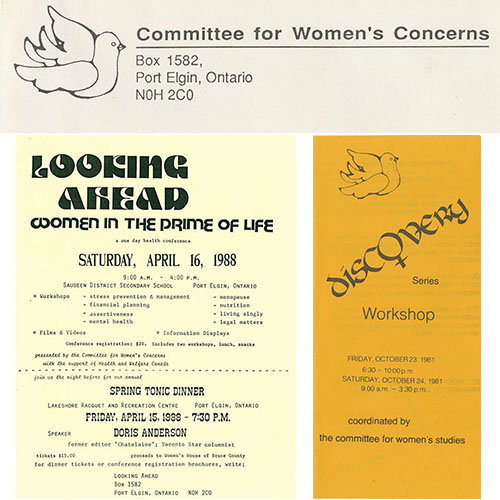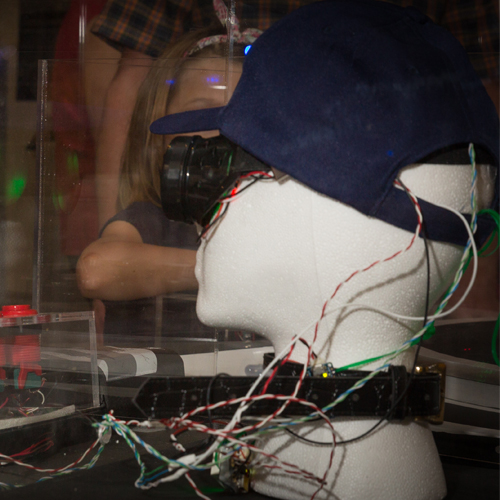Bruce County Women’s Institutes have been vital to the development of communities, families and women in Bruce County since 1898.
Bruce County Archives at BCM&CC plays an integral role in preserving over 1,400 Bruce County W.I. minute books, cash books, photographs, and Tweedsmuir Community Histories. These records are made accessible to enable all to discover, understand, and share the work of women in raising awareness of the value of women’s roles in their homes and communities, and of their work to improve our quality of life, over the past 128 years!
Women’s Institute Origins
Adelaide Hunter Hoodless has been credited as one of the official founders of the Women’s Institutes. As an educated and conscientious parent, she lost her 14-month-old child as the result of an intestinal ailment caused by drinking impure milk. She spoke to a group of 101 women (and 1 man) at a town hall meeting in Stoney Creek, Ontario, in February 1897. “She was there to promote the idea of forming rural women’s groups, to be known as Women’s Institutes”. That night, she told the women it was time to concentrate on rural living from the women’s point of view, “to elevate the job of homemaking to the same level as that of farming.” The first Women’s Institute Branch (Stoney Creek) originally existed in affiliation with the Farmers’ Institute, which began in 1884 under the auspices of the provincial Department of Agriculture. Erland Lee (a founder of the Farmer’s Institute) helped to facilitate the meeting in Stoney Creek where Adelaide made her historic speech and has been credited as the cofounder of the first Women’s Institute.
Stoney Creek W.I.’s constitution and bylaws listed as its objective: “to promote that knowledge of household science which shall lead to improvement in household architecture with special attention to home sanitation, to a better understanding of the economic and hygienic value of foods and fuels, and to a more scientific care of children with view of raising the general standard of health of our people”.
Women’s Institutes are not-for-profit charitable organizations. Local groups often centered around a small community, church, or school.
Bruce County Women’s Institutes
The first branches to form in Bruce County were Port Elgin (in 1898), Paisley (in 1900), and Walkerton (in 1901). At its peak, Bruce County District Women’s Institute consisted of 68 branches across Bruce County. Including Jr. Branches, about 74 branches have operated in Bruce County since 1998.
As of 2025, nine branches continue to meet and work: Bervie, Colpoy’s Bay, Eden Grove Cargill, Gillies Hill, Jackson, Kinloss Kairshea, Oliphant, Purple Grove, and Purple Valley. For more information, visit the “Branches” page of FWIO.
Through the network of branches, the Women’s Institute offers educational programming and community support, while advocating for social, environmental and economic change. The motto of Women’s Institutes is “For Home and Country.”
Personal Development and Educational Opportunities
Historically, many groups met monthly to share information on homemaking, health, and family, to provide educational opportunities for women, and to support each other as they raised their children and supported their family businesses. Women received training on writing and presenting papers on various topics. Some branches were involved in hosting “Short Courses”, home economics educational opportunities for women offered through the Department of Agriculture, and sponsoring or supporting local 4-H Clubs. Branches also increased awareness about important local, provincial, and national causes, giving women an opportunity to discuss and advocate.
Discussion examples include:
- Colpoy’s Bay, October 1913: “Why a homemaker should have a vacation”
- Colpoy’s Bay, June 9, 1915: “Should women have the franchise?”
- Colpoy’s Bay, May 1916: “Economy and convenience in the home”
- Walkerton, September 1916: “How can we prepare to meet the problems that shall confront us after the war”
- Walkerton, March 1, 1956: “Education on social living”
Branch committees were developed to give women the opportunity to present reports on specific areas. For example, Walkerton W.I. Standing Committees in 1954 consisted of:

Community Development and Initiatives
Many W.I. Branches were (and still are) vital to local community development. They raised money for community projects, including initiatives related to street lighting, libraries, schools, hospitals, long-term care homes, and more. During the First and Second World Wars, most branches supported soldiers through district-wide knitting projects and/or fundraising. For example, in May 1917, the Walkerton Women’s Institute raised money through donations and fundraising initiatives to donate to the Red Cross Society, Prisoners of War Duchess of Connaught’s fund, and for “war prisoner parcels.” During the Second World War that Institute developed and managed a War Work fund which was used, in part, to support men returning from the War.
The Bruce County District Women’s Institute initiated the process of designing and officially registering a Bruce County tartan, which was formally recognized in Edinburgh, Scotland, on January 19, 1965, and adopted by the County of Bruce as its official tartan.
Recording and Preserving Community History
The district supported branches in compiling Tweedsmuir community history volumes containing articles, clippings, and photographs detailing the local history of their area. This initiative was named after Lady Tweedsmuir, wife of Canada’s Governor-General, who as early as 1936, stressed the need for preserving the history of Canadians as they developed the country and their communities. Lady Tweedsmuir was an active member of England’s Women’s Institute, and she urged Canadian women to pursue historical research as one of their projects. The official launching of the Tweedsmuir Community Histories began in 1940 and branch members began gathering data on farms, homes, churches, industries, recreation, community initiatives and pioneer families. About 295 volumes of W.I. Tweedsmuir Community Histories are preserved in the Archives at BCM&CC and are used frequently by researchers searching for information about people, places and events.
Their activities in recording history led to a general desire to take more steps to preserve local history. Members of various Bruce County regional districts and branches gathered in 1952 and began working towards establishing a Bruce County Museum. That goal was achieved in 1955 with the establishment of the Bruce County Museum (now known as the Bruce County Museum & Cultural Centre).
Women’s Institute Organization
After the first group was established at Stoney Creek, others started to form. The second W.I. established was in Whitby (in the summer of 1897), and the third group was in Kemble (also in 1897). Like Stoney Creek, these branches grew out of the structure provided by the Farmer’s Institutes. Bruce County’s first branch was established in Port Elgin in 1898.
Members belong to a network that connects local Branches to Districts and Areas, as well as to the Ontario provincial level (FWIO), national level (FWIC – Federated Women’s Institutes of Canada), and international level (ACWW – Associated Country Women of the World). The FWIO was organized in 1919, providing members with a stronger voice and united group. In February 1919, the representatives from the provincial institutes met in Winnipeg, Manitoba to form the Federate Women’s Institutes of Canada (FWIC).
Seated, (L to R): Mrs. Iona Murdoch, secretary. Mrs. Kathleen McAngus, president; guest speaker, Mrs. George Wilson of St. Mary’s, regional vice-president.
Standing (L to R): Mrs. Jean Fraser, vice-president; Mrs. Ellen Cornish, vice president; Mrs. Mary Gateman, Southampton District vice-president; Mrs. Elizabeth McKeller Tiverton, federated Board member.
Legacy
Women of Bruce County have improved the quality of family, town, and rural life through the initiatives of the Women’s Institute.
Thanks to the donations of individuals and the Federated Women’s Institutes of Ontario, BCM&CC has W.I. records dating back to 1904 reflecting the important role of Bruce County W.I. branches:
- This link leads to a list of Women’s Institute minutes, administrative records and Tweedsmuir Community History books, categorized by branch, housed at the BCM&CC.
- This link leads to a list of W.I. Tweedsmuir Community History books at the BCM&CC.
- This link leads to the Federated Women’s Institute of Ontario’s Digital Collections, which include searchable digitized versions of some the W.I. Tweedsmuir Community History books.

Donating Organizations’ Records
Contact archives@brucecounty.on.ca to ask about donating your organizations’ records. Visit BCM&CC’s donations page, and scroll down to “Donate physical items, photographs, documents and more” for frequently asked donation questions.
Sources
- Ambrose, Linda M. “For Home and Country: The Centennial History of the Women’s Institutes in Ontario”. Erin: Stoddart Publishing Co. Limited, 1996. Print.
- Bruce County District Women’s Institute fonds contents, Bruce County Museum & Cultural Centre.
- Colpoy’s Bay Women’s Institute Minute Books, 1913-1915 and 1915-1916, Bruce County Museum & Cultural Centre A2015.105.039 and 040.
Federated Women’s Institutes of Ontario. “Meet the FWIO”, 2025. Federated Women’s Institutes of Ontario website, https://fwio.on.ca/meet_the_fwio.php. Accessed on February 28, 2025. - Paterson, Chris & Marion McGillivray. “Critical Years: Bruce County Museum & Archives.” Southampton: Bruce County Historical Society, 2002. Print.
- WI Canada. “Our Story”, 2020. WI Canada website, https://www.fwic.ca/history. Accessed on February 28, 2025.
- Walkerton Women’s Institute minute book, with financial statements, November 1911 – June 1917. Bruce County Museum & Cultural Centre A2015.105.127 (Financial Statement May 1917).
- Walkerton Women’s Institute minute book, September 1943-March 1945. Bruce County Museum & Cultural Centre A2015.105.127 (Financial Statements and Minutes September 1945).
Slider Photograph References
- Women’s Institute community gathering on John Bowers’ Farm, 15th Concession Huron Township, 1910s, BCM&CC A979.014.092
- Quilting party, West Arran Helpers, later known as West Arran Women’s Institute, 1940s, BCM&CC A2023.086.001
- Tiverton Women’s Institute [after 1938], BCM&CC A2017.071.037
- Tara Women’s Institute Parade Float, 1981, by Bruce Krug, A2014.003.K-81-07-21












